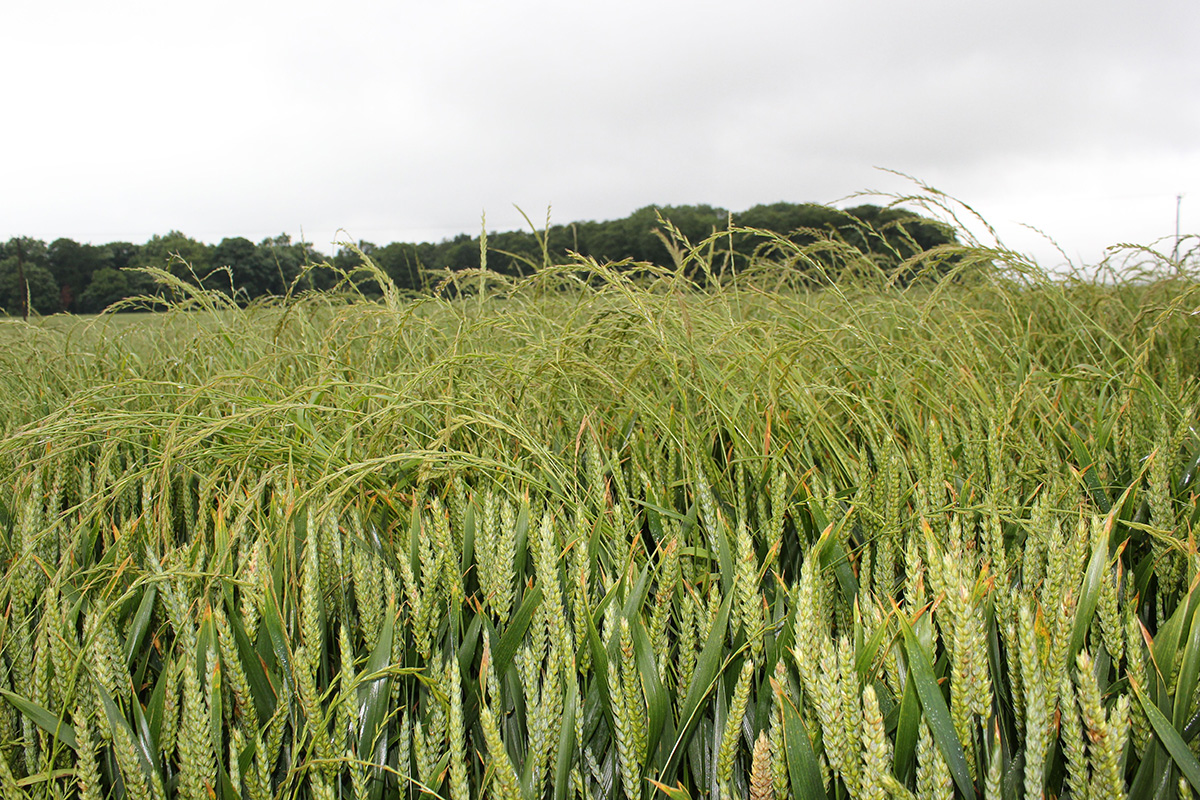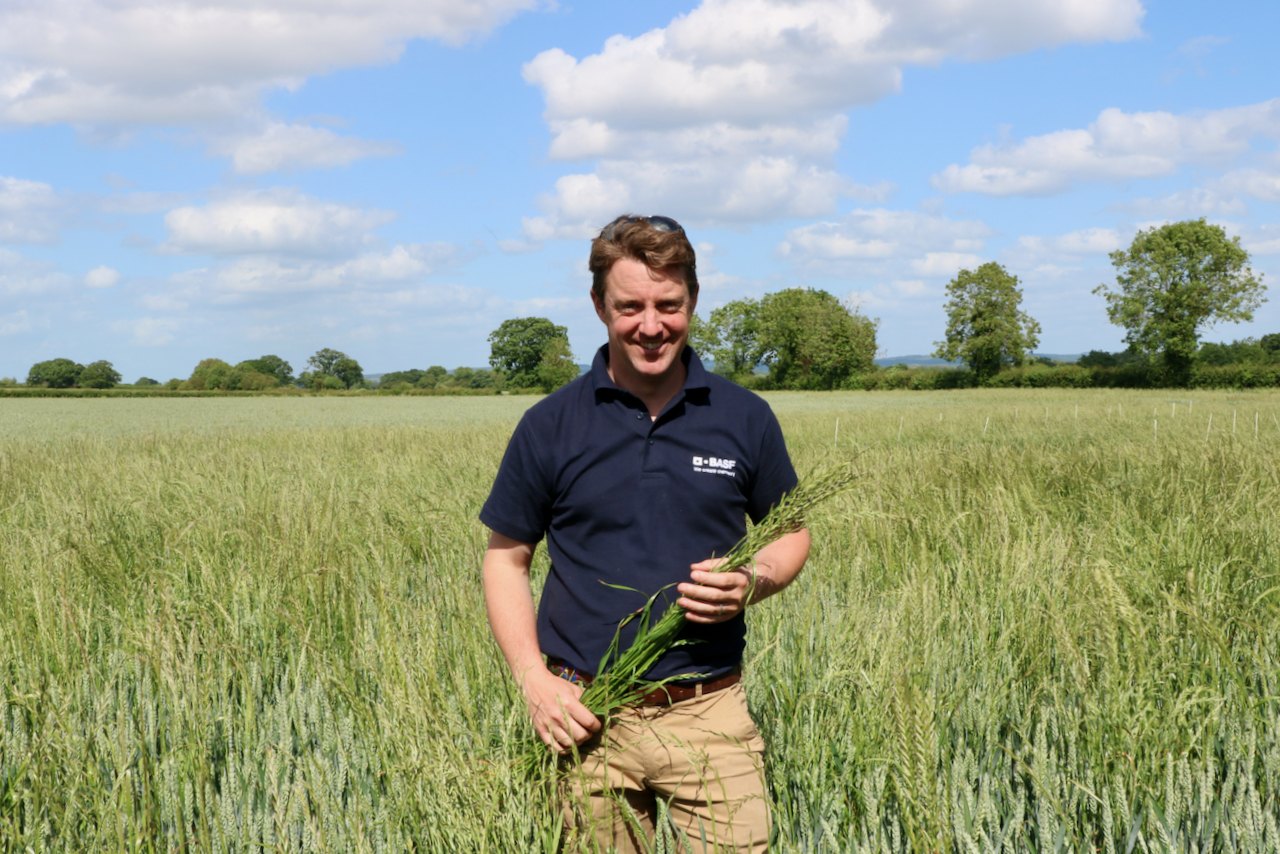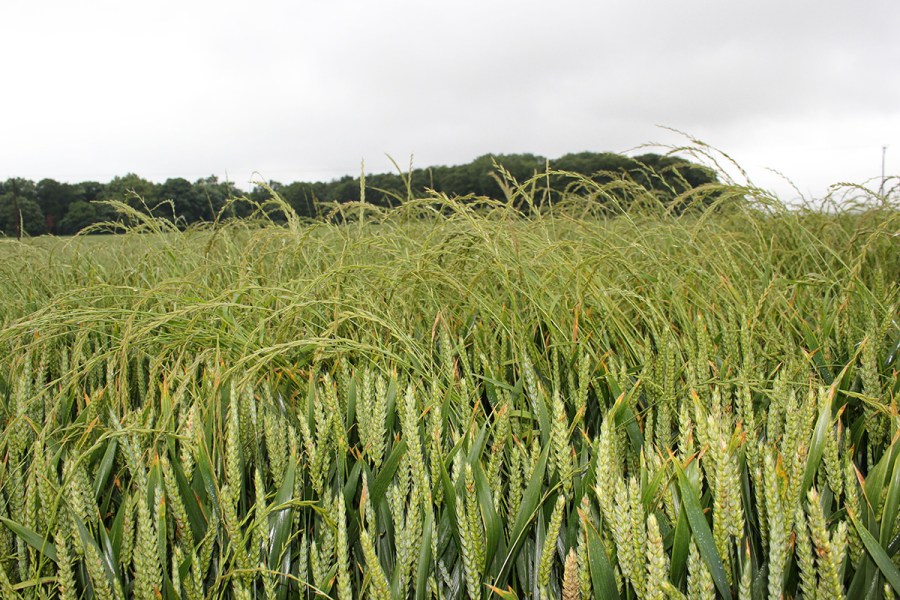
Profitability versus long term weed control was a challenge for those with blackgrass, and now a similar story is emerging with Italian ryegrass. CPM visits a farm in Staffordshire to find out how it became a problem.
We didn’t hit it head on early enough.
By Mike Abram
For farmers in the East, a heavy infestation of a pernicious grassweed has been a sadly familiar sight on altogether too many farms over the past 30 years. Now farmers in the West are having to start to come to terms with high grassweed infestations.
But it’s not the eastern scourge of blackgrass that’s proving to be the menace, it’s Italian ryegrass and, if anything, it has the potential to be even more challenging to manage effectively.
“It has crept up on us,” admits independent agronomist Bryce Rham. We’re meeting to look at a BASF Real Results small plot trial on one of his client’s farms – JB Sands Farming. The business run by Peter Sands covers around 1600ha across 10 units, on contract farming agreements, rented and owned land in Brewood, Staffordshire, plus an additional 400ha of contracting.
There’s a dichotomy between how the farm has dealt with the two different grassweeds, and the respective positions now. Blackgrass has been seen as enemy number one, and a near zero-tolerance approach has been taken to keeping it off the farm. Where the grassweed has arisen, it’s been dealt with either by spraying off, rotovating small patches or hand roguing.
“Blackgrass was never too bad and is under control. It just pops up every now and again,” says Bryce.
Italian ryegrass, however, was never seen as a problem, he admits. “Like lots of people, it has snuck up on us. I think early on, we were all guilty of considering it wasn’t a problem – it’s not blackgrass, it’s ryegrass and easily controlled – and I’m as culpable as anyone. We didn’t hit it head on early enough.”
It’s now a growing threat with Bryce categorising it as the main grassweed on about 20% of the farm, compared with just 5% five years ago. It’s bad enough in some areas to have impacted on cropping, with winter oats no longer grown on the worst blocks as in-crop control options are limited.
Across the farm, the focus is very much on winter cropping. “Spring cropping is an anathema to Peter,” says Bryce. He used to grow potatoes until the early 2000s, which he suspects may have helped control ryegrass as it’s a spring crop coupled with deep ploughing.
The plough is used periodically in the rotation – ahead of winter oats and generally winter barley, with the other cereals established using a minimum tillage system. Primary cultivations are typically down to 25cm with subsoiling also used where necessary.
Machinery has played a role in the spread of Italian ryegrass around fields and the farm. “If you miss any bit of ryegrass, with these massive combines it has suddenly chucked it everywhere.”
Balers can also be a problem. All baling on the farm is carried out by contractors and Bryce points out that farmers generally want the contractor in the field as soon as possible after the crop is cut. That can make it difficult to ask the contractor to spend time cleaning down the baler before coming to the farm, or after a particular field, when they’ve been put under pressure to be there as quickly as possible, he explains.

“Most times they will come to the farm with half a bale, which is difficult to empty out. Quite often on farm you’ll see a big patch of ryegrass or blackgrass on the second time round off the headland that’s never been there before – it’s just dropped off the baler. It’s not the contractor’s fault unless you’re prepared to pay the contractor for the time to clean down the baler.”
The growing threat of Italian ryegrass has brought a recognition that a serious effort is required to control it over the past three seasons, says Bryce. But while he says he encourages Peter to make changes – more roguing, more use of Roundup (glyphosate) to spray off areas with poor control, and to cropping and drilling date – some of those conversations are challenging when trying to balance profitability and longer term grassweed control.
Switching the planned cropping on the block where the trial is situated is one example of the lively debate that has been going on between farmer and agronomist. It’s in wheat in the current season but it’s due to be OSR next. However, at a recent meeting to discuss cropping plans, Bryce suggested winter beans should be considered instead.
“I’m convinced OSR does nothing for ryegrass control. Winter beans are definitely a better cleaning crop because it means you get the chance for two stale seedbeds before you put the beans in.
“The trouble with OSR is that the gap between cutting, baling the wheat and planting the crop is two weeks, or three at the most,” he explains.
That makes it virtually impossible to get a chit before drilling, even if the OSR is drilled in mid-August compared with the early August more commonly used in the East to combat cabbage stem flea beetle.
Making the change isn’t something that’s been an easy decision as agronomic and business objectives haven’t necessarily aligned. “I’ve suggested growing beans so that after cutting the wheat at the end of July/early August, we can use a light cultivation and spray a chit off in early September, then do another light tickle before going in with Roundup again in October. In the second week of October, put the beans in and we’ll use propyzamide, prosulfocarb, pendimethalin and clomazone.
“But Peter’s response has been, ‘it won’t make any money’,” says Bryce. With OSR at £750/t, and even £250/t, it’s definitely the most profitable break crop for the farm, he acknowledges. “I can promise you anywhere I have farmers growing winter beans we have got a significant improvement in ryegrass control.”
In the end a compromise appears to have been reached – the farm will grow about 40ha of winter beans this season with the rest of the block remaining in OSR.
There’s also a slight battle over drilling date for winter wheat. Growing a large area, Peter runs a carefully planned drilling campaign, with the aim of all the wheat being drilled by the end of September. “Everything here is about speed and efficiency. He knows exactly what he needs to do per day to keep going,” says Bryce.
However, on next year’s most at-risk wheat block following OSR, he’s suggested growing KWS Extase. Peter has been impressed by it after drilling some mid-November on a new block of land that was taken on last autumn.
Bryce says Peter asked him whether that was the one that he couldn’t drill early, with a knowing smile. He recalls his recent conversations with Peter about the fields under high ryegrass pressure where he’s argued that it’s stiff land, so would suit Extase drilled in a later slot.
“I said, the earliest I’ll be happy for you to drill it is 1 October, and preferably 7 October. So we’ll see. Peter is one of those lovely people, who looks at you and nods. But I know he is looking at me, thinking ‘you fool’.”
Early drilled wheat is putting pressure on the chemistry, however. On another farm Bryce looks after, ryegrass started to survive Atlantis (mesosulfuron+ iodosulfuron) and Axial Pro(pinoxaden) treatments about eight years ago.
“Initially you put it down to the weather, but after a couple of years you realise something is not right. So now what we’re doing is big stacks of pre-emergence residual herbicides.”
That’s evolved over a period of time from Liberator (flufenacet+ diflufenican) plus Stomp (pendimethalin) to now Liberator plus Proclus (aclonifen) plus Defy (prosulfocarb), followed by Alternator Met (flufenacet+ diflufenican+ metribuzin).
Bryce is impressed by what both Proclus and Defy are adding on ryegrass control, and after this season’s experience with post-emergence spring applied contact herbicides is convinced that any herbicides have to be applied in the autumn. “There’s no point doing anything in the spring.”
We’re walking down to the herbicide trial, which is the second year Peter has hosted one on the farm. Peter pinpointed exactly where in the field the trial should be carried out. It’s on a headland and the closer you get, you can see why he chose this particular area – there’s more Italian ryegrass than wheat, with the untreated plots already lodging in mid-June under the intense weed pressure.
David Griffiths, BASF’s agronomy manager for Shropshire, Herefordshire and Wales is here to show us around. “I think about it as an inoculated fungicide trial. It allows you to pull the differences apart.”
It’s definitely a challenging site for any herbicide. First up is a comparison between 240g/ha of flufenacet and Luximo (cinmethylin), BASF’s newly approved residual herbicide, both applied at pre-em of a crop drilled on 22 September. David is at pains to say this isn’t how either product should be used, and Luximo will not be available as a straight product, while being sold in a co-pack in year one.
Both David and Bryce agree there’s a visual improvement in the level of control from Luximo compared with flufenacet, although under this pressure neither treatment is giving what many would accept as a good level of control in a commercial situation. Based on experience and previous trials, it’s suspected the sensitivity to flufenacet has decreased but the results from resistance tests are still awaited, explains David.
“On average, in BASF trials where the straights are compared against blackgrass there is about a 22-percentage points improvement from Luximo. Against ryegrass its 26 percentage points,” he adds.
The next plots start adding to the pre-em stacks. Defy (prosulfocarb) is first up with Liberator. “The Defy is adding quite a lot,” says Bryce.
Crystal (flufenacet+ pendimethalin) plus diflufenican has also stood up well to the pressure, but Liberator plus Proclus is the cleanest plot so far. “That’s the current market standard,” he points out.
The last plot is back to Luximo, this time in combination with pendimethalin and DFF, and it is clearly the best treatment in the trial, getting closer to what would be deemed commercially acceptable, although a decent amount of ryegrass under this intense pressure is still waving in the air.
Bryce is impressed but suggests that adding 3.0 l/ha of Defy to Liberator plus Proclus would result in a similar level of control to the Luximo plus PDM plus DFF treatment.
“Luximo is miles better than flufenacet, but it needs to be compared to Liberator plus Proclus plus Defy,” he suggests. “David is going to say that’s not a fair comparison, and I agree, but it will come down to cost.”
Not surprisingly, David is not quite as willing to agree that the Defy addition to Liberator plus Proclus would match the Luximo treatment. A next plot which adds straight flufenacet early post-em to the Luximo mix hasn’t added much either, perhaps highlighting the possible sensitivity issues with flufenacet in this population.
Bryce’s initial conclusions after seeing the trial, and from other information, is to continue to use as many different actives with different modes of action in the autumn as possible. “I think where pressure is high, I will either be adding 3.0 l/ha of Defy to Luximo plus PDM plus DFF, and following up with some Alternator Met, possibly plus 2.0 l/ha Defy if I’m brave enough early post-em. Or starting with Liberator plus Proclus plus Defy and following with Luximo plus PDM plus DFF at early post-em,” he says.
David suggests it would be better to use the strongest chemistry first in the programme. “We would advocate using Luximo pre-em to get the best level of control.”
Cultural controls vital for Italian ryegrass

David Griffiths explains that the same cultural controls that are so vital to control blackgrass can also be used to help get on top of Italian ryegrass.
While Luximo will help growers with Italian ryegrass problems, it’s not a silver bullet and has to be used in conjunction with other forms of control, stresses David.
“Because of its biology, it’s actually worse than blackgrass,” he suggests. “It gets thick very quickly as it responds to nitrogen and is a very competitive weed.”
The main philosophies that have worked to some extent with blackgrass, such as stale seedbeds, delayed drilling are still important, he says.
“Spring cropping will work but perhaps to a lesser extent than with blackgrass, as ryegrass will still germinate well in the spring. Using spring cropping is more about getting opportunities to use stale seedbeds to reduce the pressure.
“The fact that it will germinate all year round given moisture does give more opportunity for stale seedbeds, even straight after harvest in August,” he adds.
Cultivation strategy is also important to consider. Rotational ploughing with complete inversion to bury seeds to a consistent depth, as with blackgrass, will help, but leave four to five years at least before ploughing to avoid bringing viable seed back to the surface, he adds.
In between ploughing, shallow tillage is preferable to avoid mixing the seed through the whole soil profile and to prevent germination of previously buried seed.
Take a zero-tolerance approach to Italian ryegrass, where possible, advises David. “Rogue or spraying out patches to avoid increasing the seedbank is worthwhile, albeit the latter can be difficult to contemplate at high prices.”
And while he recognises the issues Bryce raises with contractors, he does highlight the importance of machinery hygiene for preventing ryegrass from being imported onto farms.
The Real Results Circle

BASF’s Real Results Circle farmer-led trials are now in their sixth year. The initiative is focused on working with 50 farmers to conduct field-scale trials on their own farms using their own kit and management systems. The trials are all assessed using ADAS’ Agronomics tool which delivers statistical confidence to tramline, or field-wide treatment comparisons – an important part of Real Results.
In this series we follow the journey, thinking and results from farmers involved in the programme. The features also look at some other related topics, such as environmental stewardship and return on investment.
We want farmers to share their knowledge and conduct on-farm trials. By coming together to face challenges as one, we can find out what really works and shape the future of UK agriculture.
To keep in touch with the progress of these growers and the trials, click here.
This article was taken from the latest issue of CPM. For more articles like this, subscribe here.




